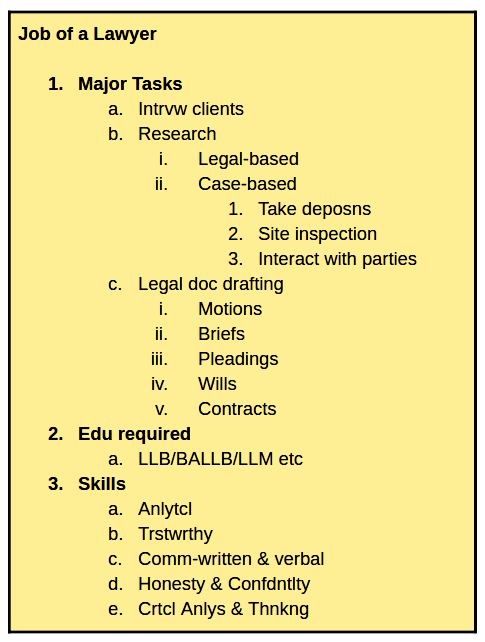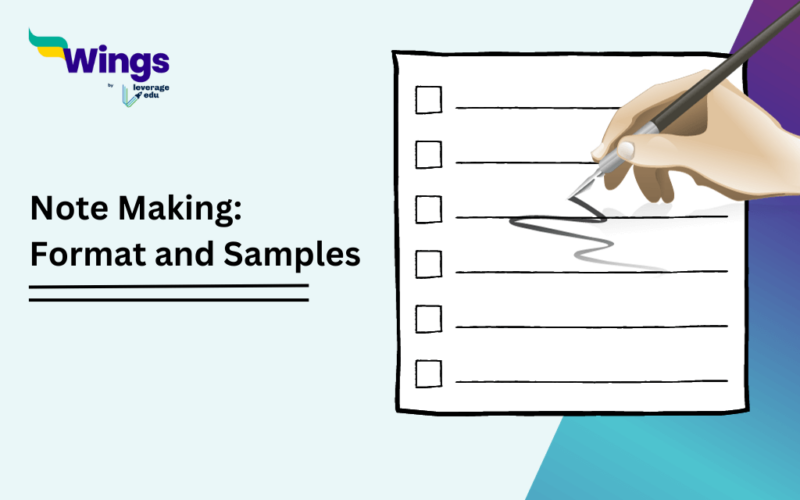Be it class 12 History or class 11 Political Science, making effective notes of vast subjects is very important for revision purposes. Apart from collating information pertinent to a multitude of subjects, note-making questions also form an integral part of the class 12 English syllabus or other such boards and exams. In such questions, which are somewhat tricky, a passage of 2-3 paragraphs is given which needs to be converted in the form of notes. At the outset, while it may seem demanding, the following are a few that steps can help you prepare efficiently and score well in the exams.
This Blog Includes:
Introduction to Note Making in English Grammar
Note-making is a process of creating a record of important details from sources such as passages, paragraphs etc. The source can also be written documents or oral communication. Note-making means recording the essence of information that is crucial.
Benefits of Note Making
Some of the benefits that the process offers are mentioned below.
- It plays a major role while you are taking an exam or academic assessment
- It helps capture the idea in a more effective way, especially if the notes made are easier for you to understand
- It also helps in fast thinking, and comprehension, memory retention, and prepares an ever-lasting record
- It maintains a primary record of lectures, meetings or studies for later use by students
- Furthermore, note-making helps in summarising and overviewing a group of information which lends a hand in recognising central issues
- It is much more convenient whenever we are looking for a specific data.
- It helps us in filtering more important topics.
- Notes are made in a natural way and in our own language, which can make understanding of a topic much easier.
How to Begin Note-Making?
Note making is a process that in itself needs a process to start with. This is mentioned below!
Give a Quick Read
One needs to understand the importance of reading before commencing the note-making task. It is important to give a quick look over the passage to get a sense of the information, its tone, ideological inclination, etc. Moreover, it helps you in knowing the main idea of the passage as well as the author’s aim in writing. However, as this is intended to develop a preliminary understanding of the passage, you must read at one stroke and leave the critical or knotty sections for when you begin your intensive reading. This should not take more than 3-5 minutes.
Intensive Read
After you are done with your quick reading session, you can now start reading attentively and carefully. As you have already gone through the passage once and are attuned to its main idea, reading the passage carefully now assists you in developing a clear grasp of the facts, opinions, arguments, and counter-arguments mentioned by the author.
- Furthermore, many passages contain a huge amount of information which you have put into categories of relevant, somewhat relevant or irrelevant. Doing this, in turn, will help you in better note making and preparation.
- You must also remember that there may be sections or opinions that you may not agree with. You should not let any such information have an impact on the notes you prepare in any way or manner. During this phase, skipping any sentence or phrase is not advisable even if you feel it is not pertinent.
Know the Word Limit
Typically, for note making questions, the word limit you must adhere to is 50-100 words. However, as per specific question patterns, the permitted word limit may change.
Systems of Note-making
In books, we generally run over bullet points. The thought behind the use of bullet points is that they give substance about something in such a manner that it becomes easy to memorise and doesn’t become easily forgettable. The purpose of note-making is similar to that i.e. to bring the users’ attention to the main data, and pull back beyond all of the other things.
Different types of Note-Making Formats
In accordance with the requirement, be it in examination, outlining, data association, etc, ther are various different types of not-making formats. Some of them are mentioned below:-
Graph or Pattern Design
This is a visual note-making approach. IN this method, the data is represented in the for a chart. Related information is present along side the same.
Mind-Map
In this technique, all the central matters and related focuses are introduced through a map or a guide. This technique also contains text as well as pictures. The data then, is connected in an appropriate grouping.
Outline or Layout Format
In this technique, the data is introduced as a blueprint and the captions and title are numbered in similar manner in this.
Prompt and Question Format
This is a visual strategy technique where the central content is featured as a progression of inquiries with respective replies. This technique helps in rapidly going through the notes easily.
Split Page Format
This is descriptive technique of note-making. In this method, the page is split into two sections. First or the primary section has the standard notes and the secondary segment will have summary. This format is the most widely recognised format for writing notes.
Note Making Format
Note making is an art. Be it for article writing, jotting down ideas for an essay on environment, story writing, or for competitive exams, you need to have an outline so as to avoid missing any important detail. Here is a rough format you can follow to solve note making questions for exams:
- Heading/Title– This is the starting section of your note which must convey the central idea of the passage. Various sub-headings and points hereon elaborate on this heading. It must be short, clear and crisp.
- Subheadings, Points, and Sub-points– Subheadings are fundamental components of a passage which further contain important information that needs to be delineated into points and subpoints.
- Abbreviations and Symbols– In order to shorten long words, it is common and permitted to use abbreviations. However, make use of abbreviative forms judiciously and remember to provide a key at the end of your note, listing all the full forms. Common symbols like ‘&, @,#, %, etc are also permitted.

Note Making Sample
After getting familiar with the basic details, let us go through a sample to understand how one can answer such questions and score well in the exam:

Here, the keys used in the note-making practice, along with the actual referenced words are mentioned below!
| Key | Word |
| Intrvw | Interview |
| Deposns | Depositions |
| Doc | Document |
| Edu | Education |
| Anlytcl | Analytical |
| Trstwrthy | Trustworthy |
| Comm | Communication |
| Crtcl-Critical | Critical |
| Confdntlty | Confidentiality |
| Anlys | Analysis |
| Thnkng | Thinking |
Methods of Note Making
So, what are the different methods that one can adopt while note-making? These are mentioned below!

Points to Remember
Now that you are well aware of the specifics of the process, go through the following tips and tricks, mistakes generally committed and how to avoid them:
- Use thesis statement: A thesis statement encapsulates the sense of the whole idea into a single and brief sentence. It can act as a road map that tells the reader about what he/she can expect while reading the included points. Write as many thesis statements as you can while preparing as this will aid you in getting the hang of writing in a short, succinct and brief manner.
- Revise at least Once: As note making requires you to trim down information, revising at least once after you have prepared your notes is vital. You may have missed relevant data pertaining to the passage.
- Use Active Voice: While preparing notes, make use of sentences only in active voice and do not use passive voice along with ‘had’, ‘have’, etc.
- Do not cross Word Limit: Note making is a play of words and crossing the word limit may result in the imposition of a penalty.
- Be Choosy: Make use of only the most relevant information and do away with whatever is already implied.
Related Reads:-
FAQs
Note-making is a process of creating a record of important details from sources such as passages, paragraphs etc. The source can also be written documents or oral communication. Note-making means recording the essence of information that is crucial.
Note making helps in fast thinking, and comprehension, memory retention, and prepares an ever-lasting record
The types of note making are
The Cornell Method.
The Outlining Method.
The Charting Method.
The Sentence Method.
The Mapping Method.
Whether you are preparing for your school or any competitive exams, note making skills can help you write better answers. If the question of what to study after 12 also bothers you then take the assistance of Leverage Edu’s psychometric test which, after gauging through your profile, will collate a list of suitable courses that align with your interest and goals
-
Nice but at the same time more informative……

 One app for all your study abroad needs
One app for all your study abroad needs




















 45,000+ students realised their study abroad dream with us. Take the first step today.
45,000+ students realised their study abroad dream with us. Take the first step today.


1 comment
Nice but at the same time more informative……